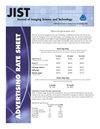基于高光谱成像的非平坦表面色素分类算法比较
IF 0.5
4区 计算机科学
Q4 IMAGING SCIENCE & PHOTOGRAPHIC TECHNOLOGY
Journal of Imaging Science and Technology
Pub Date : 2023-09-01
DOI:10.2352/j.imagingsci.technol.2023.67.5.050405
引用次数: 0
摘要
文化遗产,如绘画,为了解人类社会的历史和文化提供了宝贵的见解。保存这些文物至关重要,开发分析和保存这些文物的新技术至关重要。高光谱成像技术在文化遗产研究中有着广泛的应用,包括文献记录、材料鉴定、可视化和颜料分类等。颜料分类对于保护人员和策展人保护艺术作品以及获得与其起源相关的历史和文化背景的宝贵见解至关重要。包括机器学习在内的各种监督算法用于根据光谱特征对颜料进行分类。由于许多艺术家在他们的艺术作品中使用了浮雕技术,在表面上产生浮雕,即将其从平面物体转换为2.5D或3D,这进一步使分类任务变得困难。据我们所知,以前还没有研究利用高光谱成像对高架表面进行色素分类。因此,本研究比较了采用确定性和随机方法的不同光谱分类技术、它们的混合组合以及用于高架模型的机器学习模型,以确定这种地形变化是否会影响分类精度。在文化遗产中,缺乏足够的数据也是使用机器学习的一个重大挑战,特别是在数据收集昂贵、耗时或不切实际的领域。数据增强可以通过生成与原始样本相似的新样本来帮助缓解这一挑战。我们还分析了数据增强技术对文化遗产应用中机器学习模型有效性的影响。本文章由计算机程序翻译,如有差异,请以英文原文为准。
Comparison of Pigment Classification Algorithms on Non-Flat Surfaces using Hyperspectral Imaging
Cultural heritage objects, such as paintings, provide valuable insights into the history and culture of human societies. Preserving these objects is of utmost importance, and developing new technologies for their analysis and conservation is crucial. Hyperspectral imaging is a technology with a wide range of applications in cultural heritage, including documentation, material identification, visualization and pigment classification. Pigment classification is crucial for conservators and curators in preserving works of art and acquiring valuable insights into the historical and cultural contexts associated with their origin. Various supervised algorithms, including machine learning, are used to classify pigments based on their spectral signatures. Since many artists employ impasto techniques in their artworks that produce a relief on the surface, i.e., transforming it from a flat object to a 2.5D or 3D, this further makes the classification task difficult. To our knowledge, no previous research has been conducted on pigment classification using hyperspectral imaging concerning an elevated surface. Therefore, this study compares different spectral classification techniques that employ deterministic and stochastic methods, their hybrid combinations, and machine learning models for an elevated mockup to determine whether such topographical variation affects classification accuracy. In cultural heritage, the lack of adequate data is also a significant challenge for using machine learning, particularly in domains where data collection is expensive, time-consuming, or impractical. Data augmentation can help mitigate this challenge by generating new samples similar to the original. We also analyzed the impact of data augmentation techniques on the effectiveness of machine learning models for cultural heritage applications.
求助全文
通过发布文献求助,成功后即可免费获取论文全文。
去求助
来源期刊

Journal of Imaging Science and Technology
工程技术-成像科学与照相技术
CiteScore
2.00
自引率
10.00%
发文量
45
审稿时长
>12 weeks
期刊介绍:
Typical issues include research papers and/or comprehensive reviews from a variety of topical areas. In the spirit of fostering constructive scientific dialog, the Journal accepts Letters to the Editor commenting on previously published articles. Periodically the Journal features a Special Section containing a group of related— usually invited—papers introduced by a Guest Editor. Imaging research topics that have coverage in JIST include:
Digital fabrication and biofabrication;
Digital printing technologies;
3D imaging: capture, display, and print;
Augmented and virtual reality systems;
Mobile imaging;
Computational and digital photography;
Machine vision and learning;
Data visualization and analysis;
Image and video quality evaluation;
Color image science;
Image archiving, permanence, and security;
Imaging applications including astronomy, medicine, sports, and autonomous vehicles.
 求助内容:
求助内容: 应助结果提醒方式:
应助结果提醒方式:


